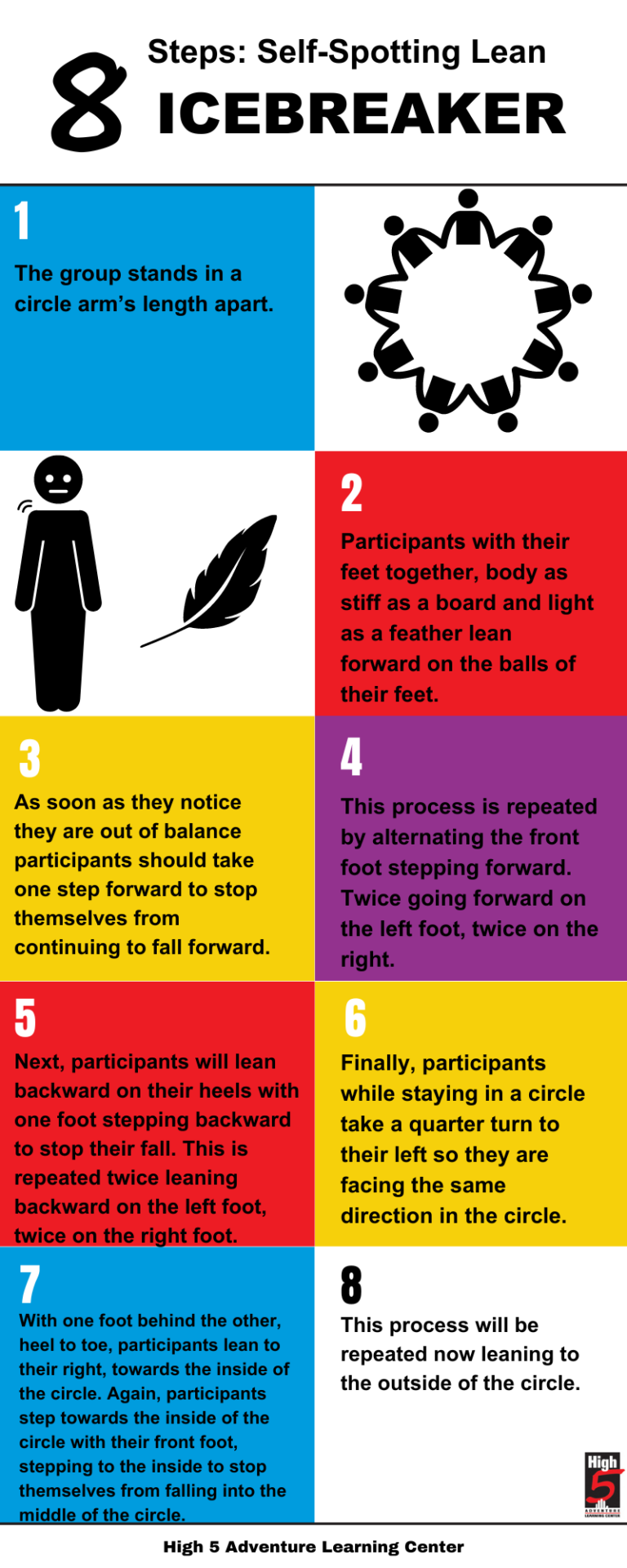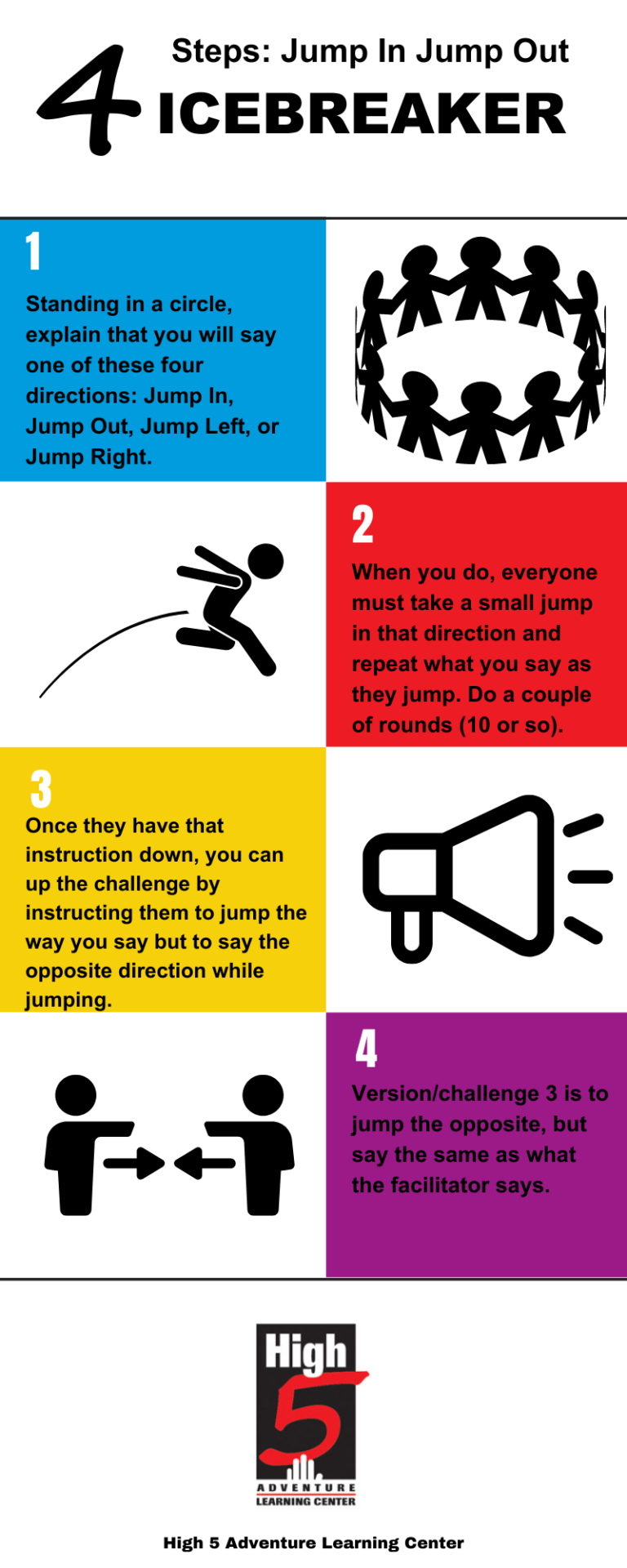3 Easy Icebreakers for Groups
Self-Spotting Leans, Jump In Jump Out & Find and Flee
Warm Up With Icebreakers for Groups
Standing before a group you don’t know and asking them to participate in an icebreaker activity isn’t easy. Or is it? At High 5, we often begin a program with icebreaker activities that typically start on the ground as a warm-up. Despite sounding like an oxymoron, warm-up icebreakers help participants stretch in building group rapport.
We use icebreaker activities that allow us, as facilitators, to know a bit about the participants, and for them to get to know a bit about us and themselves, individually, as well as other members of the group. As simple and maybe lighthearted as these activities may initially appear, there’s serious intent underlying the playfulness.
Over the years, High 5 trainers and facilitators have developed, adapted and evolved several activities, some of which will be familiar to experienced facilitators, while others may reflect subtle but unfamiliar changes. We thought sharing a few of these icebreakers with you might be of help.
Let’s look at the first of three icebreaker activities, Self-Spotting Leans, courtesy of Trainer Rich Keegan, and see how this new approach to spotting can set the tone and encourage full-on participation in the activity.
Fun Start with Self-Spotting Leans Icebreaker
Problem-solving is a skill we highly value as a participant takeaway. The challenge course continually asks participants to solve challenges that can be physical, intellectual, and emotional. As facilitators, we need to problem-solve alongside our participants. During the pandemic, we encountered new challenges in our programming that led to new adaptations. For those of us who continued doing challenge course programming during that time, the concern for safety pushed us to rethink old strategies and come up with new ideas and methods to solve physical distance needs when using low elements on challenge courses.
Some of those thoughts and practices we have continued to use on the challenge course since we have gotten back to “normal” when facilitating low elements. For example, spotters are essential for safety while participants traverse, balance and swing on various low elements. Some traditional spotting sequencing begins with practicing self-spotting. I love the self-spotting activity I learned from Nate Folan and I have made some modifications during COVID that I still use in today’s self-spotting icebreaker sequence.
Self-Spotting Leans Activity Instructions
This self-spotting icebreaker sequence is best used as an introduction to any cabled low element and serves as a great icebreaker for folks who haven’t met before.

So, why do this lean in, lean out thing? I mean, what does this do that can’t be done better by a more challenging activity? Well, adventure learning activities involve taking risks, right? Intentionally losing your balance is risky. It isn’t like free-climbing the face of El Capitan, but there is a measure of risk involved and when you take that risk you learn about yourself—and more than where your center of gravity might be located. It isn’t just how far you do lean, it’s also how far you are willing to lean. In other words, at this level where the worst thing that can happen to you is an undignified face plant, how much risk will you tolerate? Do you try to lean further each time as you go from step to step of the activity? Are you willing to take an ever bigger risk? And what is all that laughter about…?
Try Jump In Jump Out with Groups
Next, Trainer and Producer of High 5’s VPP Podcast, Phil Brown, shares a favorite icebreaker: Jump in Jump Out. He takes things further, adding verbal opposites to physical actions and introducing the need to adapt to change to succeed.

Jump In Jump Out Activity Adaptations & Considerations
Over the past decade, this activity has become a staple of my programming. I often refer to it as my “Golden Activity”, but here are some considerations I have that have developed in those years related to this activity:
- This activity is a great activity to use early on in a program and does not require you to know anyone’s name.
- It is also great to use early in a program because it has 4 characteristics that help “break the ice”:
- Fun
- Non-threatening
- Highly interactive
- Easy to understand
- Be an active participant and acknowledge the difficulty, remembering how the activity is explained and the activity itself. It’s a great way early on to connect and relate to your participants.
- I originally learned this activity as a group challenge with the participants holding hands and trying not to make any errors. This version still has its advantages, but I prefer to use this activity without the need to be success-oriented. This way I get to discuss the importance of making mistakes in our learning.
- With the right framing, it is possible to make this activity fit almost all goals/outcomes of a group which increases its versatility. For example, “Let’s play an activity that will look at our ability to adapt to change.”
Find and Flee Icebreaker with Ubuntu Cards
Lastly, let’s look at an introductory activity that uses Ubuntu cards to facilitate icebreaking for a group of strangers, or maybe folks from different departments, or administrators and staff from an organization looking to improve the way everyone interacts with one another. This one, called Find and Flee, comes from Ryan McCormick, Edge of Leadership Education Program Manager and Product Design and Development – creator of Ubuntu cards, 52 Fathoms, and Emotions by High 5® cards, as well as Blocked Perspective.

Activity Instructions & Considerations
- Divide your large group into smaller groups of about 5 people and give each player a card, single-image side up.
- On GO, everyone turns his or her card over to the multi-image side into the middle of their small group circle.
- Players attempt to find a match from their card to any other card in the small group.
- When a player finds a match, they yell it out and swap cards with the person whose card they matched.
- The player who found the match then flees his or her group and joins another small group and repeats the exercise. Only the “finder” leaves the group – the person with whom the finder swapped cards remains in the original group until he or she finds a match.
- This game can continue forever so keep an eye on the fun-o-meter and end the game while the energy is still high and people are still engaged.
Popular Variations
Polar Vortex Version: You can play this in a small group. Play as above; however, when you find a match and switch cards, you step out of the circle and out of the game. As play continues, you will end up with one person left who could not find a match. This person is frozen in the polar vortex!
Add Cardio Version: Play this in a larger open space and spread the groups out at a distance away from each other. When you find the match and flee, players must sprint to the new group. Remember to cover safety awareness regarding sprinting and running.
Reflection Tips and Strategies
During this game, it is very common for players to get stuck and not be able to find a match for a long while. I like to ask if this happened to anyone after play has stopped. Potentially these players feel like they are not good at the game, but this question allows them to see that they were not alone. This question can result in someone who was looking down to look up and say “Hey, me too!” It’s a small bit of empathy and community built through shared experience.
Final Thoughts About Icebreaker Impact
Now it’s your turn. Use these activities “as is” or change them to suit the circumstances of your group, your environment, or your style as a facilitator and trainer. Nothing is cast in stone, but you do want to be sure that any adaptations you make enhance the success of the activity and work to bring out the individuals in the group, as well as the group itself. And if you find something that works be sure to share it with us—we are always looking to improve our practice and have found that the genius of adventure educators is in their ability to innovate and willingness to change.
- Questions, Comments? Contact us at info@high5adventure.org
- Do you need a deck of Ubuntu cards to play Find and Flee? Find them in our Store.
- Bundle and Save: Ubuntu cards + Ubuntu Activity Guide© in our Store.